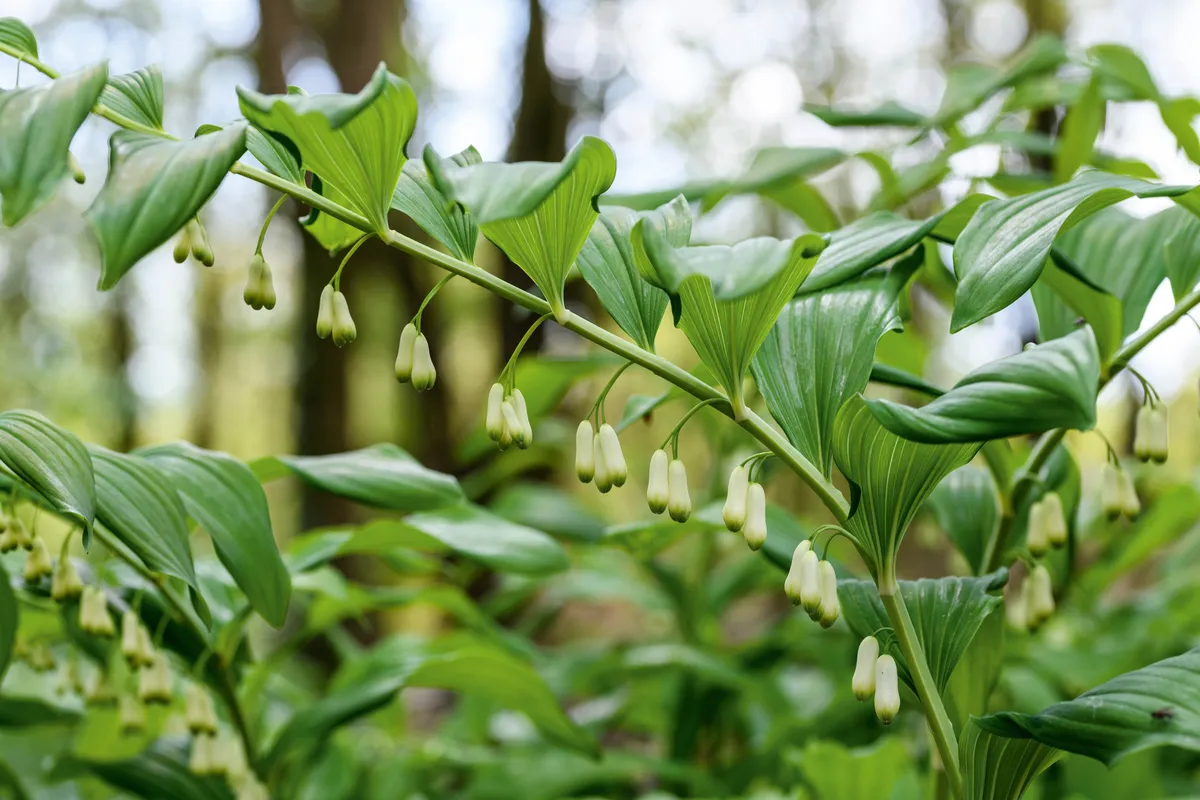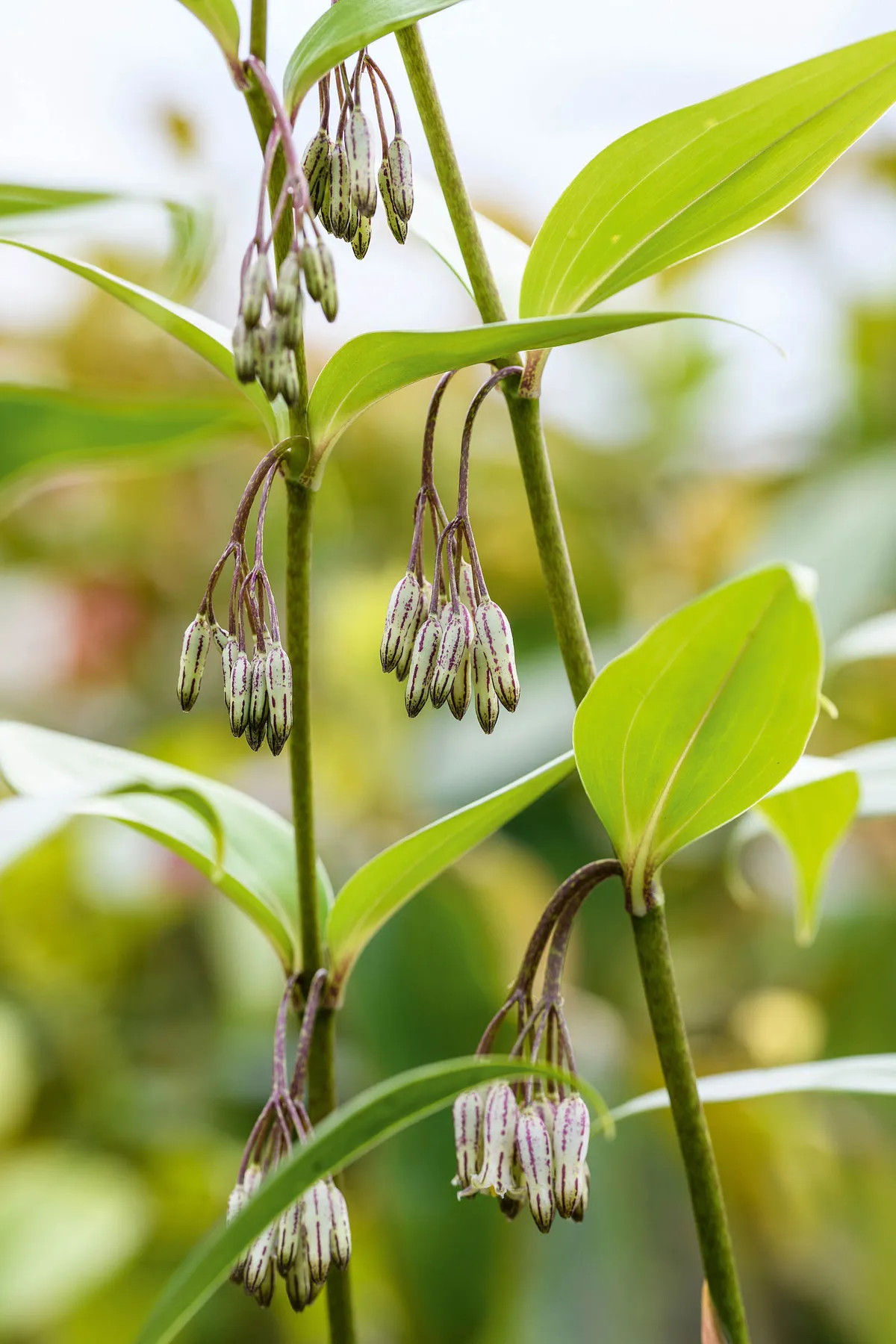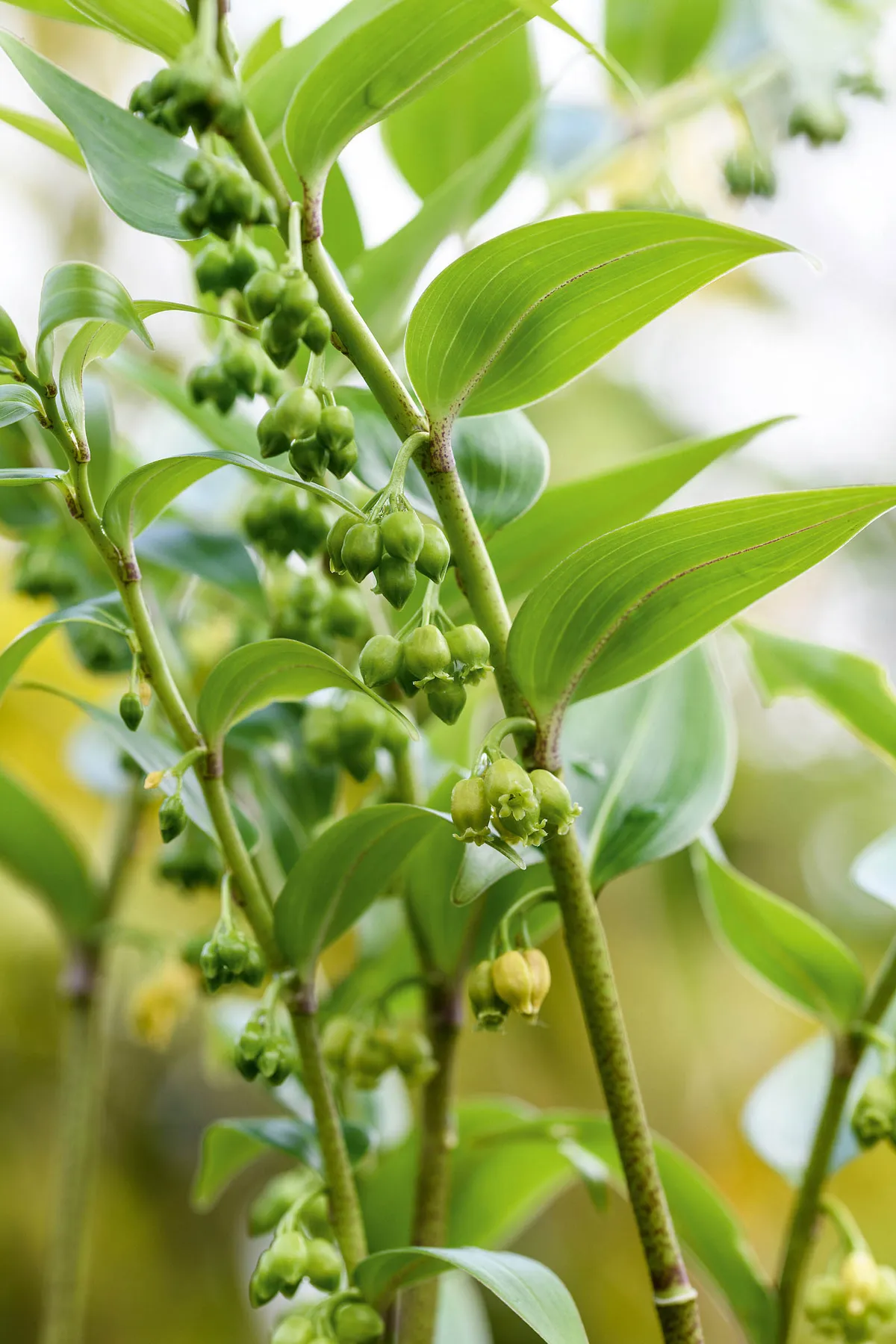Do you get as excited as I do when you see the pointy spouts of beauty erupting from the spring soil like nature’s special sculptures in the billowing days of early spring?
Polygonatum (Solomon's Seal) are rhizomatous, herbaceous perennials and members of the Asparagaceae family. The species is found in Asia, Europe, and North America and the plants love a cool dappled shade. It’s great to see this genus finally making its mark, getting more attention among other new species being discovered and cultivated, so more available for you and me to buy and plant in our gardens.
The word Polygonatum comes from the Greek ‘many knees’ referring to the knobbly structure of the joints along the rhizome. The name Solomon’s seal comes from the scar left by the previous year’s stems when it detaches from the rhizome.
IN BRIEF
What Rhizomatous, herbaceous perennial with arching stems and bell-shaped flowers that are usually white and green and sometimes followed by berries.
Origins Asia, Europe and North America.
Season Flowering in late spring and summer. The foliage is good from early spring to autumn.
Size 10cm-2m.
Conditions Moist, rich but well drained soil in dappled shade. Some are epiphyte or lithophyte, and grow on trees or rocks.
Hardiness Depends on species but most are hardy for UK gardens.
The taxonomy of Polygonatum is a constant work in progress. Bleddyn Wynn-Jones of Crûg Farm Plants in Wales is among those working on the area. In recent years, because of modern-day plant hunters discovering many new species in Asia and their breeding of some beautiful cultivars, we all enjoy so much more variety and choice for the betterment of our gardens’ allure.
If you are new to Polygonatum, maybe start by growing some of the bomb-proof options – of which there are many. The common Solomon’s seal, Polygonatum x hybridum is a fantastic garden plant, which I grow in challenging areas of the garden – even in dry shade once the roots have been established.
Polygonatums need company. Ideally, they are grown with other plants that like similar growing conditions. Their flowers are quite subtle so I like to combine other interesting woodland foliage plants such as epimediums, primulas, polystichums, corydalis and hostas. Be careful not to overdo it with the combinations so that the plants don’t become too vigorous for each other. The more vigorous species Polygonatums’ flowers are quite subtle so I like to combine other interesting woodland foliage plants look good growing out of tellimas and tiarellas. Try growing less vigorous snowdrops and crocus with them to extend the season of interest in an area.

How to grow polygonatum
Where to grow Solomon's seal
Polygonatums like a humus-rich soil that does not dry out but also never gets waterlogged. They perform best in cool, dappled shade. Don’t plant deep as this can kill the plant, so just go below the surface. I grow them in my new woodland beds, which are slightly raised so they don’t sit in winter wet. Having the beds raised also lets you and your visitors see the flowers more easily and show off their graceful arching stems properly.
Some of my favourite species grow as epiphytes in the wild. Don’t try to replicate this in your own garden but give them really good drainage and even try growing them in a rich soil mix around the base of deciduous trees such as beech. It’s usually difficult to grow anything there but drainage is good. Luckily for me, and the plants, my new woodland beds and valley banks have excellent drainage and the soil is good and rich – perfect for polygonatums.
How to propagate polygonatums
Propagation of polygonatums is easy by division or seed. The fastest way to propagate them is by division in spring – just as growth is about to start. Carefully dig up the rhizomes – do be careful not to break them. I lay them out on my potting bench where I cut up the rhizomes into 7cm lengths. They don’t have to have the growing point at the tip for the rhizome to grow into new plants. They will have dormant buds along the length of the rhizome, which will sprout new shoots when divided and potted up. This is a useful way to get many plants from a clump of polygonatum.
I collect the ripe berries in autumn, clean them and sow them fresh. They then need a period of winter cold for germination to take place. In spring they will form a small rhizome under the compost and throw up a shoot in the second year.
How to care for polygonatum
Polygonatums are extremely low-maintenance plants. All you really need to do is cut back the entire stem in spring and occasionally give them a mulch of compost. You might want to stake some of the taller polygonatums (the enormous Polygonatum zanlanscianense, for example).
Polygonatum problems
The only real problem is Solomon’s seal sawfly, which can defoliate the leaves just after flowering, but plants usually recover well after a few weeks. Some species are susceptible to slug damage when the foliage is emerging in spring, but I have never had a problem with this. They seem to be able to out-run the slugs in their eagerness to grow.
13 of the best polygonatums to grow
Polygonatum x hybridum

The common Solomon’s seal is an absolute cracker of a plant. Tall, arching stems with white-and-green, bell-shaped flowers. This polygonatum grows well in dry shade once established and is a true survivor in so many old gardens. 1-1.5m.
Polygonatum oppositifolium

A native of the Himalayas where it grows as an epiphyte or a lithophyte. Its arching stems have shiny green leaves in opposite pairs. Foliage is evergreen and the cream flowers with purple stripes are followed by red fruit. 1m.
Polygonatum odoratum

One of three native species that grow in the UK. It has distinctive foliage with the leaves slightly folded back in pairs, which allow the flower to be seen easily. I also grow it for its lily- scented and bell-shaped, green-and-white flowers. 50cm-1m.
Polygonatum costatum

This species is near the top of my wish list. From high in the mountains of northern Thailand, Myanmar and Yunnan, it has attractive reddish stems and white flowers followed by red fruit that generally lasts through the winter. 30-40cm.
Polygonatum kingianum

A rare but spectacular polygonatum, I first saw growing in a shaded glasshouse in Tom Hudson’s Tregrehan Gardens. Often listed as P. vietnamicum, it’s worth searching out for its whorls of red-pink flowers. It’s tender and slugs love new growth so I grow it in a large pot in my glasshouse. 2.5m.
Polygonatum verticillatum

Its pendulous, bell-like, cream flowers with green tips are followed by black or red fruit. Stems grow with whorls of narrow leaves that take on beautiful yellow autumn colour as it dies down. 1-2m. RHS H4.
Polygonatum mengtzense

This is a semi-evergreen polygonatum with purplish arching stems with greenish white flowers followed by red fruit. This plant is slow to bulk up with me but definitely worth growing. 35cm.
Polygonatum hirtum

Nearly round leaves and pendent white flowers with green tips followed by berries in autumn. Low growing but bulks up well. Very useful to grow at the front of a woodland border where it won’t get hidden by larger plants. 30cm.
Polygonatum multiflorum ‘Betberg’

One of the most beautiful spring foliage plants. The new foliage is a purple-brown colour as it emerges. Clusters of creamy flowers with a green tip are followed by purple berries. 60-75cm. RHS H7.
Polygonatum punctatum

Evergreen and epiphytic in its native eastern Nepal and west Sikkim, this small species has scattered to whorled foliage along the stems and flowers with white and purple spots followed by red fruit in autumn and winter. 40-50cm.
Polygonatum arisanense

A Crûg Farm introduction from Taiwan and one of the most beautiful. It has tall arching stems with clusters of white and green bell-like flowers in spring. A good polygonatum for bulking up well and adding a real statement in a shady garden. 1.2-2m.
Polygonatum odoratum ‘Red Stem’

This is one of my favourites with its beautiful red stems, which look attractive all through the growing season. It is a short plant and has the typical white bell-shaped flowers with green tips. 60cm. USDA 3a-8b.
Polygonatum multiflorum ‘Ramosissima’

This polygonatum grows well for me on the slopes in the valley where it forms arching stems that I can look up into the plant to see the flowers. As they age the racemes become leafy. The flowers are white and green. 1m.
Where to buy polygonatum
Crûg Farm Plants Griffith’s Crossing, Caernarfon, Gwynedd LL55 1TU. Tel 01248 670232, crug-farm.co.uk
Long Acre Plants Charlton Musgrove, nr Wincanton, Somerset BA9 8EX, Tel 01963 32802, plantsforshade.co.uk
Pan-Global Plants The Walled Garden, Frampton Court, Frampton-on-Severn, Gloucestershire GL2 7EX.
Tel 01452 741641, panglobalplants.com